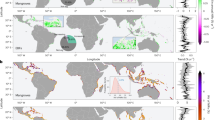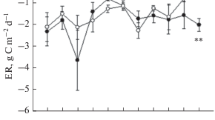Abstract
We analyzed the ecosystem effects of low-temperature events (<5 °C) over 4 years (2009–2012) in subtropical short and long hydroperiod freshwater marsh and mangrove forests within Everglades National Park. To evaluate changes in ecosystem productivity, we measured temporal patterns of CO2 and the normalized difference vegetation index over the study period. Both water levels and distance from the coast influenced the ecosystem response to low-temperature events. Photosynthetic capacity, or the maximum CO2 uptake rate, and sensitivity to low-temperature events were much higher in mangrove forest than in freshwater marsh ecosystems. During low-temperature events photosynthetic capacity was enhanced in freshwater marsh while it declined in mangrove forests, and respiration rates declined across Everglades ecosystems. While the long hydroperiod freshwater marsh gained 0.26 g CO2 m−2 during low-temperature events, the mangrove forest had the greatest C lost (7.11 g CO2 m−2 low-temperature event−1) followed by the short hydroperiod freshwater marsh (0.37 g CO2 m−2 low-temperature event−1). Results suggest that shifts in the frequency and intensity of weather anomalies with climate change can alter C assimilation rates in Everglades ecosystems through effects on the photosynthetic capacity of existing species, which might lead to changes in species composition and ecosystem productivity in the future.





Similar content being viewed by others
References
Adam P (1990) Saltmarsh ecology. Cambridge University Press, Cambridge
Baldocchi D (2014) Measuring fluxes of trace gases and energy between ecosystems and the atmosphere – the state and future of the eddy covariance method. Glob Chang Biol 20(12):3600–3609. doi:10.1111/gcb.12649
Barr JG, Engel V, Fuentes JD, Zieman JC, O’Halloran TL, Smith TJI, Anderson GH (2010) Controls on mangrove forest-atmosphere carbon dioxide exchanges in western Everglades National Park. Journal of Geophysical Research 115(G2). doi:10.1029/2009JG001186
Boucek RE, Gaiser EE, Liu H, Rehage S (2016) A review of subtropical community resistance and resilience to extreme cold spells. Ecosphere:1–23
Brocklebank JC, Dickey DA (2003) SAS System for Forecasting Time Series (1986 ed.), SAS Institute Inc. Cary, North Carolina
Chen E, Gerber JF (1992) Climate. In: Myers RL, Ewel JJ (eds) Ecosystems of Florida (pp. 11–30) Orlando
Comeaux RS, Allison MA, Bianchi TS (2012) Mangrove expansion in the Gulf of Mexico with climate change: Implications for wetland health and resistance to rising sea levels. Estuarine, Coastal and Shelf Science 96(C):81–95. doi:10.1016/j.ecss.2011.10.003
Davis JH (1940) The ecology and geologic role of Mangroves in Florida. Publications of the Carnegie Institution of Washington 517:303–412
Davis SM, Ogden JC (eds) (1994) Everglades, the Ecosystem and its Restoration. Delray Beach: St. Lucie Press, Delray Beach, FL, USA
Davis SM, Childers DL, Lorenz JJ, Wanless HR, Hopkins TE (2005) A conceptual model of ecological interactions in the mangrove estuaries of the Florida Everglades. Wetlands 25(4):832–842. doi:10.1672/0277–5212(2005)025[0832:ACMOEI]2.0.CO;2
Duke N, Ball M, Ellison J (1998) Factors influencing biodiversity and distributional gradients in mangroves. Global Ecology & Biogeography Letters 7(1):27–47. doi:10.1111/j.1466–8238.1998.00269.x
Ewe SML, Gaiser EE, Childers DL, Iwaniec D, Rivera-Monroy VH, Twilley RR (2006) Spatial and temporal patterns of aboveground net primary productivity (ANPP) along two freshwater-estuarine transects in the Florida Coastal Everglades. Hydrobiologia 569(1):459–474. doi:10.1007/s10750–006–0149-5
Field, C. D. (1995). Impact of expected climate change on mangroves. In Asia-Pacific Symposium on Mangrove Ecosystems (pp. 75–81). Dordrecht: Springer Netherlands. doi:10.1007/978-94-011-0289-6_10
Gilman EL, Ellison J, Duke NC, Field C (2008) Threats to mangroves from climate change and adaptation options: A review. Aquatic Botany 89(2):237–250. doi:10.1016/j.aquabot.2007.12.009
Goulden ML, Munger JW, FAN SM, Daube BC, Wofsy SC (1996) Measurements of carbon sequestration by long-term eddy covariance: Methods and a critical evaluation of accuracy. Global Climate Change Biology 2(3):169–182. doi:10.1111/j.1365-2486.1996.tb00070.x
Gu Y, Brown JF, Verdin JP, Wardlow B (2007) A five-year analysis of MODIS NDVI and NDWI for grassland drought assessment over the central Great Plains of the United States. Geophysical Research Letters 34(6):L06407–L06406. doi:10.1029/2006GL029127
IPCC (2007) Climate Change 2007: The Physical Science Basis, Contribution of Working Group I to the Fourth Assessment Report of the Intergovernmental Panel on Climate Change. (S. Solomon, D. Qin, M. Manning, Z. Chen, M. Marquis, & K. B. Averyt, Eds.). Cambridge University Press, Cambridge, United Kingdom and New York, NY, USA
Jacquin A, Sheeren D, Lacombe J-P (2010) Vegetation cover degradation assessment in Madagascar savanna based on trend analysis of MODIS NDVI time series. International Journal of Applied Earth Observation and Geoinformation 12:S3–S10. doi:10.1016/j.jag.2009.11.004
Jansen M, Bergsträsser S, Schmittgen S, Müller-Linow M, Rascher U (2014) Non-Invasive Spectral Phenotyping Methods can Improve and Accelerate Cercospora Disease Scoring in Sugar Beet Breeding. Agriculture 4(2):147–158. doi:10.3390/agriculture4020147
Jimenez KL, Starr G, Staudhammer CL, Schedlbauer JL, Loescher HW, Malone SL, Oberbauer SF (2012) Carbon dioxide exchange rates from short- and long-hydroperiod Everglades freshwater marsh. Journal of Geophysical Research 117(G4):G04009. doi:10.1029/2012JG002117
Kangas PC, Lugo AE (1990) The distribution of mangroves and saltmarsh in Florida. Tropical Ecology 31(1):32–39
Kodra, E., Steinhaeuser, K., & Ganguly, A. R. (2011). Persisting cold extremes under 21st-century warming scenarios. Geophysical Research Letters, 38(8), n/a–n/a. doi:10.1029/2011GL047103
Krauss KW, Doyle TW, Twilley RR, Rivera-Monroy VH, Sullivan JK (2006) Evaluating the relative contributions of hydroperiod and soil fertility on growth of south Florida mangroves. Hydrobiologia 569(1):311–324. doi:10.1007/s10750–006–0139-7
Krauss KW, From AS, Doyle TW, Barry MJ (2011) Sea-level rise and landscape change influence mangrove encroachment onto marsh in the Ten Thousand Islands region of Florida, USA. Journal of Coastal Conservation 15:629–638. doi:10.1007/1s1852-101-0153-4
Loescher HW, Law BE, Mahrt L, Hollinger DY. (2006) Uncertainties in and interpretation of, carbon flux estimates using the eddy covariance technique. J Geophys Res-Atmos 111. D21S90, doi:10.1029/2005JD006932
Loveless CM (1959) A study of the vegetation in the Florida Everglades. Ecology 40(1):1–9. doi:10.2307/1929916
Malone SL, Staudhammer CL, Oberbauer SF, Olivas P, Ryan MG, Schedlbauer JL, et al. (2014) El Niño southern oscillation (ENSO) enhances CO2 exchange rates in freshwater marsh ecosystems in the Florida Everglades. PLoS One 9(12):e115058. doi:10.1371/journal.pone.0115058
Markley JL, McMillan C, Thompson GA Jr (1982) Latitudinal differentiation in response to chilling temperatures among populations of three mangroves, Avicennia germinans, Laguncularia racemosa, and Rhizophora mangle, from the western tropical Atlantic and Pacific Panama. Canadian Journal of Botany 60(12):2704–2715. doi:10.1139/b82-330
Marshall, C. H., Pielke, R. A., Sr, Steyaert, L. T., & Willard, D. A. (2004). The impact of anthropogenic land-cover change on the Florida peninsula sea breezes and warm season sensible weather. Monthly Weather Review, 132(1), 28–52. doi:10.1175/1520–0493(2004)132 < 0028:TIOALC > 2.0.CO;2
McKee KL, Cahoon DR, Feller IC (2007) Caribbean mangroves adjust to rising sea level through biotic controls on change in soil elevation. Global Ecology and Biogeography 16(5):545–556. doi:10.1111/j.1466–8238.2007.00317.x
Noe GB, Childers DL, Jones RD (2001) Phosphorus Biogeochemistry and the Impact of Phosphorus Enrichment: Why Is the Everglades so Unique? Ecosystems 4(7):603–624. doi:10.1007/s10021–001–0032-1
Obeysekera J, Browder J, Hornung L, Harwell MA (1999) The natural South Florida system I: Climate, geology, and hydrology. Urban Ecosystems 3(3):223–244. doi:10.1023/A:1009552500448
Osland MJ, Enwright N, Day RH, Doyle TW (2013) Winter climate change and coastal wetland foundation species: salt marshes vs. mangrove forests in the southeastern United States. Global Change Biology 19(5):1482–1494. doi:10.1111/gcb.12126
Pennings, S. C., & Bertness, M. D. (2001). In M. D. Bertness, S. D. Gaines, & M. Hay (Eds.), Salt marsh communities (pp. 289–316). Sunderland.
Perry W (2004) Elements of south Florida's comprehensive Everglades restoration plan. Ecotoxicology 13:185–193
R Core Team (2014) R: A language and environment for statistical computing. R Foundation for Statistical Computing, Vienna, Austria Retrieved from http://www.R-project.org
Reeves MC, Bagget LS (2014) A remote sensing protocol for identifying rangelands with degraded productive capacity. Ecological Indicators 43:172–182. doi:10.1016/j.ecolind.2014.02.009
Rivera-Monroy VH, Twilley RR, Davis SE, III, Childers DL, Simard M, Chambers R, et al. (2011) The role of the everglades mangrove ecotone region (EMER) in regulating nutrient cycling and wetland productivity in South Florida. Crit Rev Environ Sci Technol 41(sup1):633–669. doi:10.1080/10643389.2010.530907
Ross MS, Meeder JF, Sah JP, Ruiz PL, Telesnicki GJ (2000) The Southeast Saline Everglades revisited: 50 years of coastal vegetation change. Journal of Vegetation Science 11(1):101–112. doi:10.2307/3236781
Ross, M. S., Ruiz, P. L., Sah, J. P., Reed, D. L., & Walters, J. (2006). Early stand development following disturbance along a mangrove forest productivity gradient in South Florida. Plant Ecology.
Ross MS, Ruiz PL, Sah JP, Hanan EJ (2009) Chilling damage in a changing climate in coastal landscapes of the subtropical zone: a case study from south Florida. Global Change Biology 15(7):1817–1832. doi:10.1111/j.1365–2486.2009.01900.x
Saintlian N, Wilson N, Rogers K, Rajkaran A, Krauss KW (2014) Mangrove expansion and salt marsh decline at mangrove poleward limits. Global Change Biology 20:147–157
Schedlbauer JL, Oberbauer SF, Starr G, Jimenez KL (2010) Seasonal Differences in the CO2 Exchange of a Short-Hydroperiod Florida Everglades Marsh. Agricultural and Forest Meteorology 150(2010):994–1006. doi:10.1016/j.agrformet.2010.03.005
Schedlbauer JL, Munyon JW, Oberbauer SF, Gaiser EE, Starr G (2012) Controls on Ecosystem Carbon Dioxide Exchange in Short- and Long-Hydroperiod Florida Everglades Freshwater Marshes. Wetlands 32(5):801–812. doi:10.1007/s13157–012-0311-y
Spackman W, Dolsen CP, Riegel W (1966) Phytogenic Organic Sediments and Sedimentary Environments in the Everglades-Mangrove Complex. Part I: Evidence of a Transgressing Sea and its Effects on Environments of the Shark River Area of Southwestern Florida. Palaeontographica Abteilung B:135–152
Stevens PW, Fox SL, Montague CL (2006) The interplay between mangroves and saltmarshes at the transition between temperate and subtropical climate in Florida. Wetlands Ecology and Management 14(5):435–444. doi:10.1007/s11273–006–0006-3
Stuart SA, Choat B, Martin KC, Holbrook NM, Ball MC (2007) The role of freezing in setting the latitudinal limits of mangrove forests. New Phytologist 173(3):576–583. doi:10.1111/j.1469–8137.2006.01938.x
Tomlinson PB (1986) The botany of mangroves. Cambridge University Press, New York
Troxler T, Gaiser EE, Barr J, Fuentes JD, Jaffe R, Childers DL, et al. (2013) Integrated carbon budget models for the Everglades terrestrial-coastal-oceanic gradient: current status and needs for inter-site comparisons. Oceanography 26(3):98–107. doi:10.5670/oceanog.2013.51
Vavrus S, Walsh JE, Chapman WL, Portis D (2006) The behavior of extreme cold air outbreaks under greenhouse warming. International Journal of Climatology 26(9):1133–1147. doi:10.1002/joc.1301
Wanless HR, Vlaswinkel BM (2005) Coastal landscape and channel evolution affecting critical habitats at Cape Sable, Everglades National Park, Florida. Everglades National Park Service, U.S. Department of Interior
Woodroffe CD, Grindrod J (1991) Mangrove Biogeography: The Role of Quaternary Environmental and Sea-Level Change. Journal of Biogeography 18(5):479. doi:10.2307/2845685
Acknowledgments
The authors would like to acknowledge the excellent support provided by the United States Forest Service Rocky Mountain Research Station (RMRS) and the Florida Coastal Everglades Long Term Ecological Research Program (FCE LTER) for their ongoing support. This manuscript is partly based upon work supported by the National Science Foundation through the FCE-LTER program under Grant DEB-1237517. This research is also based in part on support from the Department of Energy’s (DOE) National Institute for Climate Change Research (NICCR) through grant 07-SC-NICCR-1059. Any opinions, findings, and conclusions or recommendations expressed in this material are those of the authors and do not necessarily reflect the views of the RMRS or DOE.
Author information
Authors and Affiliations
Corresponding author
Electronic Supplemental Material
Figure S1
Low-temperature event frequencies at short (TS-1) and long hydroperiod (SRS-2) freshwater marsh and mangrove forest (SRS-6) sites in Everglades National Park. (GIF 40.1 kb)
Figure S2
Observed (black) and modeled (blue) daily NEE at (a.) short- (TS-1) and (b.) long-hydroperiod (SRS-2) freshwater marsh and (c.) mangrove forest (SRS-6) sites in Everglades National Park. Vertical lines show low-temperature events at each site. (GIF 125 kb)
Figure S3
Observed (points) and modeled (dashed lines) monthly NDVI at (a.) short- (TS-1) and (b.) long hydroperiod (SRS-2) freshwater marsh and (c.) mangrove forest (SRS-6) sites in Everglades National Park. (GIF 71.4 kb)
Rights and permissions
About this article
Cite this article
Malone, S.L., Barr, J., Fuentes, J.D. et al. Sensitivity to Low-Temperature Events: Implications for CO2 Dynamics in Subtropical Coastal Ecosystems. Wetlands 36, 957–967 (2016). https://doi.org/10.1007/s13157-016-0810-3
Received:
Accepted:
Published:
Issue Date:
DOI: https://doi.org/10.1007/s13157-016-0810-3




